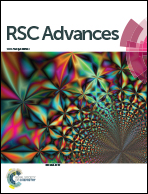Removal of reactive brilliant red X-3B by a weak magnetic field enhanced Fenton-like system with zero-valent iron†
Abstract
The effect of a weak magnetic field (WMF) on the removal of reactive brilliant red X-3B (X-3B) by zero-valent iron (ZVI)/H2O2 was studied. The optimum conditions for the removal of X-3B by the ZVI/H2O2/WMF system were as follows: pH = 4.0, X-3B was 50 mg L−1, H2O2 was 8 mM, and ZVI with particle size of 20 μm was 0.5 g L−1. The X-3B decolorization rate could reach 99.41% in 10 minutes. The superposed WMF increased the working pH of ZVI from 3.0 to 4.0. The main part of ZVI/H2O2 removal kinetics of X-3B followed the zero order rate law. In this study, the removal effect of X-3B by pre-magnetization ZVI was not as good as that of real-time magnetization, but it was better than the removal of X-3B by the ZVI/H2O2 system. The ZVI/H2O2/WMF system still had the ability to remove X-3B after 4 consecutive cycles. The use of WMF improved the removal of X-3B by ZVI/H2O2 mainly due to the corrosion of ZVI. Under acidic conditions, WMF enhanced the activity of ZVI, which promoted the efficiency of the Fenton reaction. The use of WMF to enhance the ZVI/H2O2 removal X-3B was a promising and environmental friendly process because it did not require additional energy and expensive reagents and did not cause secondary pollution.



 Please wait while we load your content...
Please wait while we load your content...